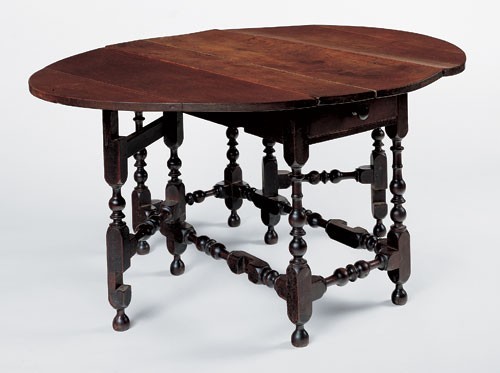
Gateleg table, Newport, Rhode Island, 1710–1740. Maple with white pine and chestnut. H. 28", W. 59 1/8" (open), D. 48 3/8". (Private collection; photo, Gavin Ashworth.)

Table, Boston, Massachusetts, 1700–1730. American walnut, European walnut, and fruitwood with white pine; slate. H. 27 1/4", W. 40", D. 25 1/8". (Courtesy, American Antiquarian Society.) This table originally belonged to the Reverend Nehemiah Walter (1663–1751) of Roxbury, Massachusetts.

Tea table, Boston, Massachusetts, 1700–1730. Mahogany. H. 26 1/2", W. 32 1/2", D. 21 3/4". (Private collection; photo, Gavin Ashworth.)

Baluster design illustrated on pl. 94 in Augustin-Charles d’Aviler’s Cours d’architecture qui comprend les ordres de Vignole (1691). (Courtesy, Beinecke Rare Book and Manuscript Library, Yale University.)

Detail of a staircase in Harvard House, Stratford-upon-Avon, Warwickshire, England, late seventeenth century. (Courtesy, Shakespeare Birthplace Trust.) Built in 1596, this house was the boyhood home of John Harvard (1607–1683), founder of Harvard University.

Detail of the balusters leading to the gallery of the Seventh Day Baptist Meeting House, Newport, Rhode Island, ca. 1730. (Courtesy, Newport Historical Society; photo, Gavin Ashworth.)

Baluster from the staircase in the Governor William Coddington House (demolished in 1835), Newport, Rhode Island, ca. 1641. (Courtesy, Newport Historical Society; photo, Gavin Ashworth.) This staircase baluster salvaged from the house likely dates to ca. 1730.

Wanton-Lyman-Hazard House, Newport, Rhode Island, ca. 1697. (Photo, Gavin Ashworth.) One of the few surviving Newport buildings with details rooted in baroque classicism, this house has undergone extensive renovations during its history.

Detail of the staircase in the Wanton-Lyman-Hazard House. (Photo, Gavin Ashworth.) This staircase was probably added during an eighteenth-century renovation.

Detail of a baluster from the staircase in the Wanton-Lyman-Hazard House. (Photo, Gavin Ashworth.) This oak baluster was part of what was likely the original attic staircase.

Table, Newport, Rhode Island, 1700–1730. Maple with white pine, H. 26 3/4", W. 54 3/4", D. 28 5/8". (Courtesy, National Park Service, William Floyd Estate.) This table was originally constructed as a draw-bar table. The drawer is a later addition, the top is a replacement, and the feet are missing.
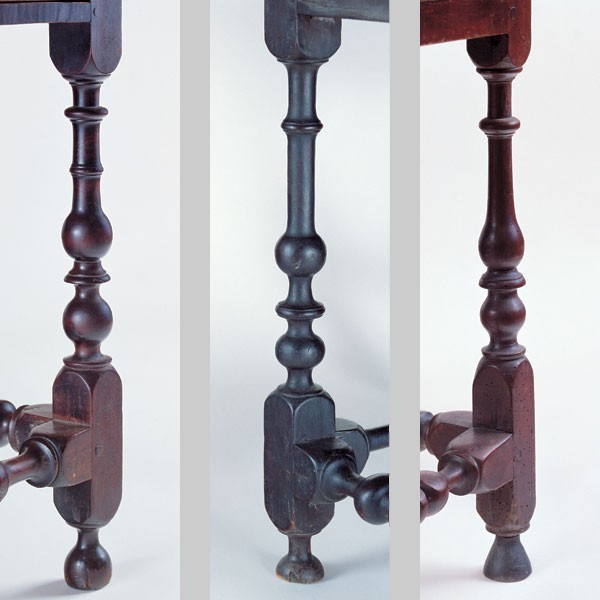
Details of the legs of the gateleg tables illustrated (from left to right) in figs. 1, 19, 21. The leg on the left is from a table in group one, the leg in the center is from a table in group two, and the leg on the right is from a table in group three. (Photos, Gavin Ashworth.)
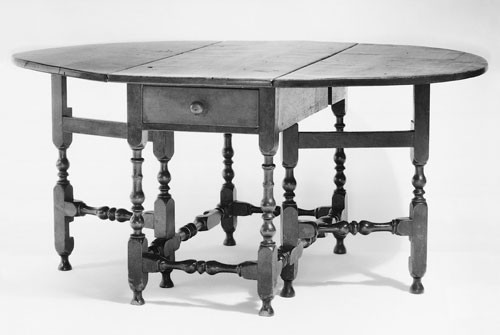
Gateleg table, Newport, Rhode Island, 1710–1740. Maple with white pine and oak. H. 27 3/4", W. 60" (open) 21 1/4", D. 48 1/4". (Private collection; photo, P. Richard Eells.)
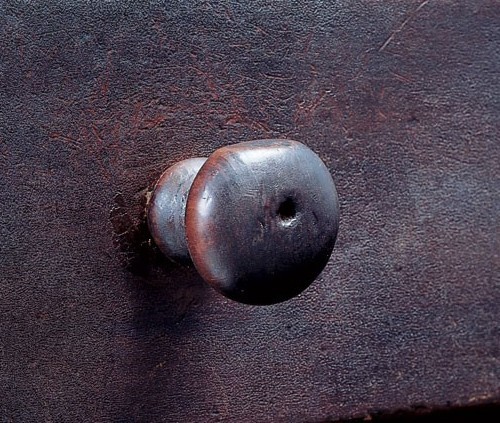
Detail of the drawer knob of the gateleg table illustrated in fig. 13. (Photo, Gavin Ashworth.)

Detail of the drawer dovetail of the gateleg table illustrated in fig. 13. (Photo, Gavin Ashworth.)

Drawing representing how the stationary legs of the table illustrated in fig. 1 are laminated, (Artwork, Wynne Patterson.)

Gateleg table, Newport, Rhode Island, 1710–1740. Maple with white pine. H. 28", W. 57 3/4" (open), D. 48 3/8". (Courtesy, Metropolitan Museum of Art, gift of Mrs. Russell Sage.)

Detail of the stationary leg of the gateleg table illustrated in fig. 17. (Photo, Gavin Ashworth.)
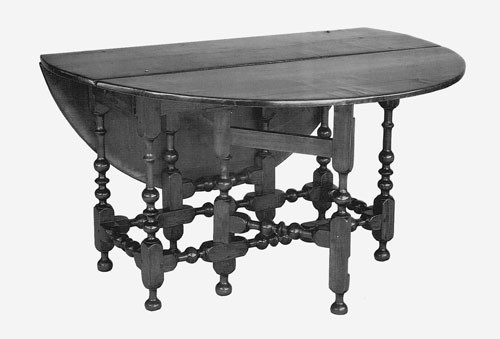
Gateleg table, Rhode Island, 1710–1740. Maple with unidentified secondary woods. H. 27", W. 53 1/2" (open), D. 49 1/2". (Courtesy, Nathan Liverant & Son, Inc.)
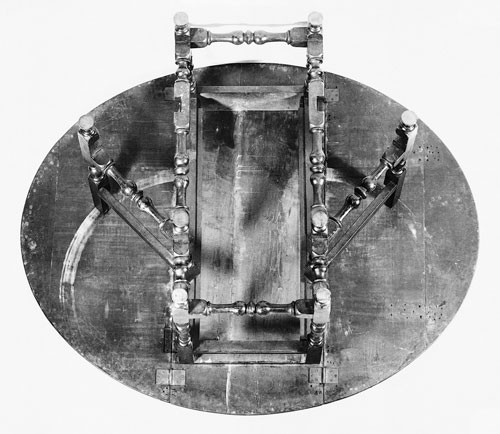
Underside of the gateleg table illustrated in fig. 13. The rectangular hinges are positioned outside the frame and the gates pivot at the same end.

Gateleg table, Rhode Island, 1710–1740. Maple with white pine. H. 27 1/4", W. 41" (open), D. 49 5/8". (Private collection; photo, Gavin Ashworth.)

Gateleg table, Rhode Island, 1710–1740. Maple with white pine and cherry. H. 28 1/2", W. 57" (open), D. 47 3/4". (Chipstone Foundation; photo, Gavin Ashworth.)

Detail of the stationary leg of the gateleg table illustrated in fig. 22. (Photo, Gavin Ashworth.)

Side chair, Rhode Island, 1710–1740. Ash. H. 49 1/2", W. 20 1/4", D. 15". (Private collection; photo, Gavin Ashworth.) The crest, finials, and bottom row of stretchers are replacements.

Gateleg table, Rhode Island, 1710–1740. Maple. H. 27 3/4", W. 59" (open), D. 47 1/4". (Private collection; photo, Gavin Ashworth.) The feet are replacements.

Detail of a wrought-iron hinge on the gateleg table illustrated in fig. 25.

Stool, Newport, Rhode Island, 1710–1740. Maple. H. 21 1/4", W. 22 1/8", D. 13 1/2". (Courtesy, Yale University Art Gallery, gift of C. Sanford Bull, B.A. 1893.) Although the lower ball turning is omitted, the rings and moldings of this stool are virtually identical to those on the gateleg tables in group one.
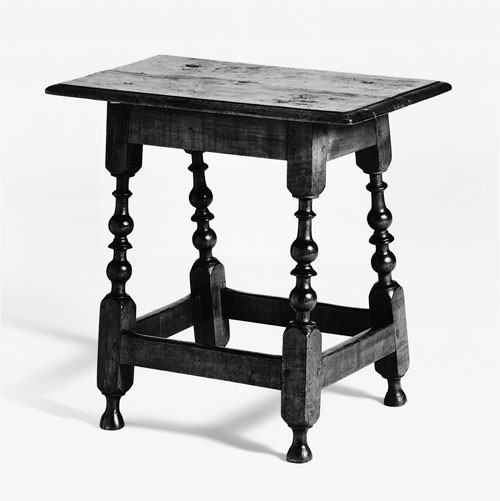
Stool, Newport, Rhode Island, 1710–1740. Maple. H. 22", W. 13 1/4", D. 23 1/4". (Courtesy, Winterthur Museum.)

Table, Rhode Island, 1710–1740. Maple. H. 25 7/8", W. 15 1/2", D. 26". (Private collection; photo, Gavin Ashworth.)

Table, Rhode Island, 1710–1740. Maple with white pine. H. 29", W. 48", D. 29 3/4". (Courtesy, Sotheby’s Inc.)

Table, Rhode Island, 1710–1740. Maple frame. H. 22 7/8", W. 15 1/2", D. 23 3/4". (Private collection; photo, Gavin Ashworth.) The top is an incorrect replacement.
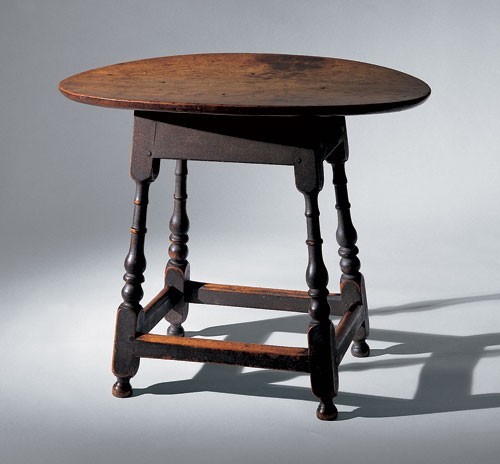
Table, Rhode Island, 1710–1740, Maple. H. 23 1/2", W. 20", D. 28 3/4". (Private collection.)
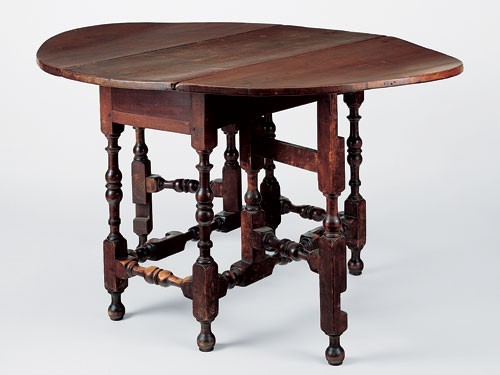
Gateleg table, probably Rhode Island, 1710–1740. Maple. H. 25 1/2", W. 53 3/4" (open), D. 42". (Private collection; photo, Gavin Ashworth.) The feet are replaced.

Gateleg table frame, probably Rhode Island, 1710–1740. Maple. H. 25 5/8", W. 15 7/8", D. 31 7/8". (Private collection; photo, Gavin Ashworth.)

Gateleg table, probably Rhode Island, 1710–1740. Maple. H. 27", W. 53" (open), D. 48". (Private collection; photo, Gavin Ashworth.)
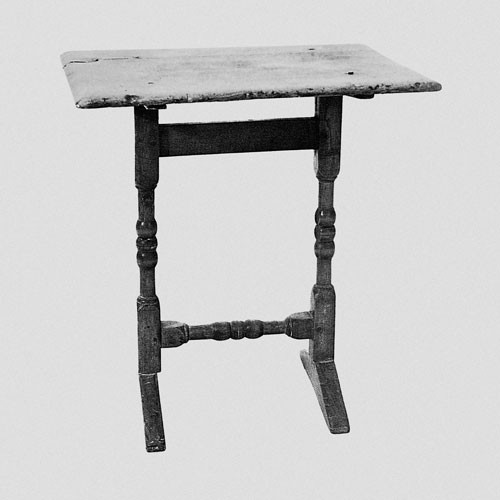
Table, probably Rhode Island, 1710–1740. Maple with oak and white pine. H. 26", W. 24", D. 17". (Private collection; courtesy, Peter Eaton Inc.)

Candlestand, probably Rhode Island, 1710–1740. Maple. H. 23 3/4", W. 13 1/2", D. 13 1/4". (Private collection; photo, Gavin Ashworth.)

Gateleg table, probably Rhode Island, 1710–1740. Maple. H. 27", W. 53 3/4" (open), D. 45 3/4". (Private collection; photo, Gavin Ashworth.)

Candlestand, probably Rhode Island, 1710–1740. Maple. H. 29 1/8", W. 12 3/4", D. 12 5/8". (Private collection; photo, Gavin Ashworth.)
Driven primarily by the marketplace, the majority of twentieth-century Rhode Island furniture scholarship has focused on the late baroque and rococo styles. Although the admiration bestowed on these objects is justified, it has left a chasm in the study of that colony’s early furniture. As noted by Robert Blair St. George and Robert Trent, this lapse is further exacerbated by the limited amount of seventeenth- and early eighteenth-century furniture that survives. A recent study by the authors has identified an important group of Rhode Island gateleg tables (fig. 1) and shown how elements of their design were adapted to later furniture forms. This article elaborates on this research and examines the origin of the turning designs, the architectural prototypes, the breadth and diversity of objects made, and the probability of multiple makers.[1]
Irving W. Lyon was the first scholar to illustrate an example of what is now considered a classic Rhode Island turning in his seminal book The Colonial Furniture of New England (1891). A decade later, Frances Clary Morse published a gateleg table from that colony in Furniture of the Olden Time. Neither Lyon nor Morse, however, ascribed these objects to a particular area. It was not until 1950 that Albert Sack attributed this turning pattern to Rhode Island in Fine Points of Furniture.[2]
Rhode Island tables differ significantly from those made in the other New England colonies, which typically have legs with symmetrical turnings (figs. 2, 3). An antecedent for this symmetrical design is found on plate 94 in Augustin-Charles d’Aviler’s (1653–1701) Cours d’architecture qui comprend les ordres de Vignole (1691) (fig. 4). Mirrored balusters were occasionally described as double poire, or “double pear.” During the first half of the eighteenth century, craftsmen working along Narragansett Bay developed alternatives to this archetypal design. The origins of these patterns are unknown, but similar baluster shapes and arrangements occur in late seventeenth- and early eighteenth-century British furniture and interior architecture (fig. 5).[3]
Recent research has established links between Rhode Island furniture turnings and related architectural work. In an earlier volume of American Furniture Luke Beckerdite pointed out similarities between turned balusters from the Seventh Day Baptist Meeting House in Newport (fig. 6) and those on regional gateleg tables. Although the balusters from the meetinghouse and similar examples salvaged from the Governor Coddington House (fig. 7) are not exact cognates for the furniture turnings under discussion, they do have individual elements handled in much the same way. Most notably, the upper sections of the architectural turnings have attenuated balusters of the same basic shape as those on the gates of several Rhode Island tables. The architectural turnings lack the intricate moldings that separate the balusters and lower spherical turnings on many tables, but that does not eliminate the possibility that some are products of the same shop or turning tradition. The architectural turnings from the Seventh Day Baptist Meeting House and Coddington House may be slightly later than some of the tables.[4]
The stair balusters in the Wanton-Lyman-Hazard House (figs. 8-10) are among the earliest architectural turnings from Newport. More important, they relate closely to the legs on a Newport table (fig. 11) that belonged to William Floyd (1734–1821) of Brookhaven, Long Island. Given the fact that the Floyd family had resided in Setauket since the mid–seventeenth century, it is likely that the table arrived in Long Island soon after its construction. The repetitive nature of the eighteenth-century turner’s trade lent itself to the production of standard forms that were easily adaptable to various architectural and furniture components. As the balusters in the Wanton-Lyman-Hazard House and those on the Floyd table reveal, turners often used the same basic designs for both furniture and architectural work.[5]
Rhode Island Gateleg Tables: The Development of a Regional School of Turning
Most of the known Rhode Island gateleg tables can be divided into three groups based on their turnings and construction (fig. 12). Group one consists of eight examples with complex leg turnings. The balusters of the legs have spherical bases with abrupt transitions to tall slender necks, and seven of these tables have two different ring turnings at the top. Only two of these tables have relevant histories. One descended in the Easton family of Newport, and the other (fig. 13) in the Alden-Southworth-Cooke family of Little Compton and Newport. The latter table is strikingly similar to the one illustrated in figure 1; even the drawer knobs are virtually identical (fig. 14).[6]
The construction of tables in the first group is consistent but relatively generic. Drawers are supported on runners attached to the side rails, drawer fronts are secured at each side with a single large dovetail (fig. 15), top boards are pinned to the side rails, and gates pivot from the same end of the table. Tables from Britain and New York occasionally exhibit this gate arrangement.[7]
Of all the gateleg tables in the first group, the example illustrated in figure 1 is in the best condition. Its feet have minimal wear, and most of the original black paint survives on the base. The legs are made of laminated boards (fig. 16), a rare detail in colonial American furniture. Because the turner glued up the stock from boards of different sizes, the joints are not centered. Furniture makers often laminated stock to avoid removing excess waste or to compensate for lack of materials. Neither scenario is completely satisfactory in explaining the laminated legs of this table because the turning cross-sections are relatively uniform and there was an abundance of maple, the table’s primary wood, in New England.[8]
The table illustrated in figure 17 is included in the first group, even though its stationary legs have balusters with a single, pronounced ring turning on the neck (fig. 18). The molding sequence below its balusters, however, is similar to that on other tables in the first group and its construction and gate arrangement are identical. Of all the tables in group one, the turnings on this example are the most exaggerated. The rings on the necks of the balusters are broad with sharp torus moldings, and the upper and lower necks of the spherical turnings below the balusters are unusually long. In both execution and conception they differ significantly from the more academic turnings on the tables shown in figures 1 and 13.
The second group of gateleg tables is composed of four examples (fig. 19) with turnings that are simpler than those of group one (see fig. 12). The lower sections of the balusters are more compressed, there is a single ring on the neck, and the molding sequence separating the baluster from the spherical turning below consists of a distorted cavetto over a conventional astragal. Structural differences include the use of a central drawer runner, a conventional gate arrangement, and pins driven through the top into the upper stiles of the stationary legs. Like the tables in the first group, those in group two have drawer fronts secured with a single large dovetail at each side and hinges that do not extend under the sides of the frame (fig. 20). This eliminated the need to notch the side rails as was done on many colonial gateleg tables.[9]
The stationary legs on tables in the third group have baluster turnings with a more conventional shape, displaying a gradual sweep from the base to the neck (fig. 21). These tables have gates that pivot at the same end and moldings below the balusters similar to those in group one, central drawer supports like tables in group two, and drawer dovetailing and hinge placement consistent with both groups.[10]
Two other gateleg tables can be considered part of this regional school, but neither can be associated with a known group. The turnings on the table illustrated in figure 22, in particular the shallow ring on the neck (fig. 23) and distinctive ball feet, are unlike those on other Rhode Island examples (see fig. 1). The leg turnings on the table, however, are nearly identical to the back post turnings of a bannister-back side chair attributed to Rhode Island (fig. 24). Both objects also have remarkably similar stretchers. The table has been altered significantly, and the drawer replaces what was originally a simple end rail with a molded lower edge.[11]
The other Rhode Island gateleg table made without a drawer (fig. 25) bears no relation to the altered one (fig. 22). The large torus on the upper leg squares and pronounced single ring on the column are idiosyncratic, as are the form and placement of the hinges. The maker used crude wrought-iron straps (fig. 26) rather than the conventional rectangular or butterfly hinges found on other Rhode Island examples and attached them to the underside of the top inside the frame. This location helped compensate for the weakness of the thin straps. The maker may have been unable to obtain imported hardware or simply preferred the products of a local blacksmith.[12]
Related Furniture Forms
Several tables and stools have turning sequences that match those found on Rhode Island gateleg tables. The legs of the small stool illustrated in figure 27 relate directly to those on tables in group one, but the maker eliminated the lower spherical element to compensate for the difference in height. Three other stools with similar turnings are known. Another related example has a spherical turning at the bottom (fig. 28). Turners often used similar designs for architectural components and the legs of tables and stools, adding or subtracting elements to accommodate the size, function, and context of the finished product.[13]
A number of rectangular tables (figs. 29, 30) can be linked with the examples constituting group two. Like the gateleg tables, the rectangular forms have balusters with ball-shaped bottoms and similar moldings separating them from the spherical turning below. Another trait common among the small tables is a V-shaped astragal on the neck of the baluster.[14]
The table illustrated in figure 31 is from group three, and, as with nearly all Rhode Island examples of this form, each of its legs splays outward, canting in only one direction. Only two tables and a stool with legs canted in two directions are known. The oval-top table illustrated in figure 32 has turnings that are reminiscent of those on the gateleg examples in group three, but the upper ring turning on its balusters is unusual and its dome feet have an added fillet. All of the double-canted forms have identical feet and similar transitions from the upper and lower turnings into the leg squares. These objects may constitute an entirely separate group.[15]
Variations from the Standard
The gateleg tables and related forms discussed above document the emergence and development of a Rhode Island school of turning; however, regional styles were rarely monolithic. Several tables attributed to that colony differ significantly from those in or on the periphery of the standard subgroups. The table illustrated in figure 33 has stationary legs with symmetrical balusters separated by a thin V-shaped torus molding; thus the mass of the turning is located in the center of the design rather than at the bottom. It does, however, have balusters with a relatively sharp break at the neck and shares some construction features with the examples in the second group.[16]
Two additional gateleg tables (figs. 34, 35), a trestle table (fig. 36), and a small group of candlestands (fig. 37) have related turnings. The V-shaped astragal molding separating the baluster turnings on the stand is identical to those in the same position on the legs of the gateleg table frame illustrated in figure 34. Cross-base candlestands and trestle tables are usually associated with Massachusetts and Connecticut; thus it is plausible that these objects were made in the border areas of Rhode Island.[17]
Another variant of the opposing baluster design can be observed on the gateleg table illustrated in figure 38. With precise and delicate turnings, it is the most refined example of this genre. The turnings are reminiscent of those on the gateleg table illustrated in figure 33, but the elements are more in scale with the form. Aside from the two dovetails joining the drawer front and sides, the construction is similar to that of tables in group two. Although the table illustrated in figure 38 is somewhat idiosyncratic, it could easily be an urban product. A sophisticated candlestand that reputedly descended in a Rhode Island family has similar turnings (fig. 39). With its scroll legs, octagonal top, and pendant drop, this stand represents the pinnacle of the baroque design and fashion in Rhode Island furniture.[18]
The school of turning covered in this study reflects the work of a core group of furniture craftsmen and other regional artisans influenced by them. Surprisingly, few references to turners occur in early eighteenth-century Rhode Island records, and none are listed in Newport documents from this period. A few tradesmen described as “turners” were active in other areas of Rhode Island including King’s County (present-day Washington County) in the colonial period. The 1727 inventory of Judah Wordin (d. 1727) of Westerly lists carpenters’ and turners’ tools, but like many rural artisans he probably performed a variety of woodworking activities, such as joinery, chair making, and turning, as well as doing seasonal farming. It is doubtful that many of the turned tables in the Rhode Island school were produced in rural areas, as nonurban craftsmen rarely achieved the production levels or had sufficient long-term patronage and stylistic sophistication to account for this large group of furniture. Rather, the artisans who produced these table, stool, stand, and architectural turnings were probably among the many joiners and house carpenters listed in the records of Newport and other Rhode Island towns. Period documents describe Reuben Peckham (1676–1736) of Newport and East Greenwich, Rhode Island, as a joiner, but he did turning as well. The 1736 inventory of his East Greenwich shop lists joiners’ tools, two workbenches, unfinished case furniture, “1 Leath [lathe] and turning tools,” “1 grindstone,” and “Sundry Table Legs.” His household goods included three oval tables, one described as “small.” The executors of Peckham’s estate sold the small table for £1.11 in May 1737. The oval tables were probably gateleg forms or simpler four-leg examples without folding leaves. Similarly, recent scholarship suggests that the renowned Newport furniture maker Christopher Townsend (1701–1787) made turned and joined tables, stair balusters and pendants, and architectural paneling as well as ambitious case furniture.[19]
Given the fact that it represents the work of several different hands, the Rhode Island school of turning is remarkably cohesive. It is likely that many factors contributed to the development and persistence of this regional style. As a group, the colony’s inhabitants differed from their counterparts in other areas of New England. During the seventeenth century, Rhode Island became a destination for Quakers escaping persecution in England and Massachusetts. Religious strictures against marriage outside their faith and social pressures emphasizing the support of other Quakers facilitated the establishment of family businesses and patronage networks. Given the fact that many Quaker artisans were linked through marriage, apprenticeship, or business, it should come as no surprise that strong regional styles emerged in several areas of Rhode Island. A desire for commercial independence from Massachusetts may also have been an influence. In a 1739 letter to John Thomlinson of London, Newport merchant John Bannister wrote that the residents of his town desired “to make themselves independent of the Bay Government to whom they have a mortal aversion.” The stylistic independence manifest in the Rhode Island school of turning foreshadowed what was to come. By the time Bannister wrote his letter, Newport furniture makers had developed innovative construction methods and established alliances with merchants and shippers that would enable them to compete with their counterparts in Boston and other northern ports.[20]
ACKNOWLEDGMENTS
For kind assistance with this article, the authors thank Glenn Adamson, Alan Anderson, Mr. and Mrs. Brian Bartizek, Luke Beckerdite, John Benson, Richard Benson, Victor Chinnery, Edward S. Cooke Jr., Phillip DeDominicis, Mr. and Mrs. John Demos, Ann Donnelly, Peter Eaton, Mr. and Mrs. Dudley Godfrey, Mr. and Mrs. Norman Gronning, Morrison Heckscher, Patricia Kane, Kevin Keane, Kimberly Krauer, Brock Jobe, Rev. Ledlie Laughlin Jr., Dean Levy, Frank Levy, Bertram Lippincott, Mr. and Mrs. John Little, Arthur Liverant, Dr. and Mrs. Richard Mones, John Philbrick, Marie Plummer, Jonathan Prown, Frances Safford, Myron Stackiw, Mr. and Mrs. Stanley Tananbaum, Adams Taylor, Mr. and Mrs. Tonnesen, Robert Trent, Tony Trowles, Kevin Tulimieri, Mr. and Mrs. Fred Vogel, and Joan Youngken.
Robert Blair St. George, The Wrought Covenant: Source Material for the Study of Craftsmen and Community in Southeastern New England, 1620–1700 (Brockton, Mass.: Brockton Art Center and Fuller Memorial, 1979); Robert F. Trent, “New Insights on Early Rhode Island Furniture,” in American Furniture, edited by Luke Beckerdite (Hanover, N.H.: University Press of New England for the Chipstone Foundation, 1999), pp. 209–23; and Erik K. Gronning and Dennis Carr, “Rhode Island Gateleg Tables,” Antiques 165, no. 5 (May 2004): 122–27.
Irving Whitall Lyon, The Colonial Furniture of New England (New York: E. P. Dutton, 1891), p. 202, fig. 102; Frances Clary Morse, Furniture of the Olden Time (New York: Macmillan Co., 1901), p. 224. Albert Sack, Fine Points of Furniture: Early American (New York: Crown Publishers, 1950), pp. 238, 240. Oswaldo Rodriguez Roque discussed two tables with a history of ownership in Rhode Island in American Furniture at Chipstone (Madison: University of Wisconsin Press, 1984), pp. 278–79.
Augustin-Charles d’Aviler, Cours d’architecture qui comprend les ordres de Vignole. 2 vols. (Paris: Chez Nicolas Langlois, 1691), 1: 319, pl. 94. This book was reissued several times during the first half of the eighteenth century. The authors thank Victor Chinnery for providing information about British antecedents for Newport turnings—particularly the staircase at Harvard House (Shakespeare Birthplace Trust)—and for sharing his knowledge of related English furniture turnings. For a staircase with similar details, see Royal Commission on Historical Monuments (England): An Inventory of the Historical Monuments in London, vol. 1, Westminster Abbey (London: His Majesty’s Stationery Office, 1924), pl. 179. This stair was added to the Little Cloister of Westminster Abbey in the late seventeenth century. A similar staircase is illustrated in Walter H. Godfrey, The English Staircase: An Historical Account of Its Characteristic Types to the End of the XVIIIth Century (London: B. T. Batsford, 1911), pls. 40, 41.
Luke Beckerdite, “The Early Furniture of Christopher and Job Townsend,” in American Furniture, edited by Luke Beckerdite (Hanover, N.H.: University Press of New England for the Chipstone Foundation, 2000), pp. 7–10. Myron O. Stackiw, The Early Architecture and Landscapes of the Narragansett Basin, vol. 1, Newport (Newport, R.I.: Vernacular Architecture Forum, 2001), pp. 107–9.
For more on the Wanton-Lyman-Hazard House, see Antoinette F. Dowling and Vincent J. Scully Jr., The Architectural Heritage of Newport Rhode Island: 1640–1915, 2nd ed. (New York: Bramhall House, 1967), pp. 435–37, pls. 29–37; Antoinette F. Dowling, Early Homes of Rhode Island (Richmond, Va.: Garrett & Massie, 1937), pp. 70–72. The date of this house is based on recent dendrochronology. The authors thank Myron Stackiw for providing this information and discussing his study of the house. Dean F. Failey, Long Island Is My Nation: The Decorative Arts and Craftsmen, 1640–1830, 2nd ed. (Cold Spring Harbor, N.Y.: Society for the Preservation of Long Island Antiquities, 1998), p. 28, fig. 26. St. George, Wrought Covenant, p. 44, fig. 34b. Roderick H. Blackburn et al., Dutch Colonial Homes in America (New York: Rizzoli, 2002), p. 84. Originally constructed as a draw-bar table, the Floyd table is a unique New England example. All other known draw-bar tables originate in New York, and very few are known with related turnings.
For the eight known tables, see Northeast Auctions, New Hampshire Auction, Portsmouth, N.H., August 1–3, 2003, lot 778; Ruth Davidson, “Living with Antiques: The Connecticut Home of Mrs. C. McGregory Well Jr.,” Antiques 81, no. 1 (January 1962): 101–3; Sotheby’s, Important Americana: The Collection of Dr. and Mrs. Henry P. Deyerle, Charlottesville, Va., May 26–27, 1995, lot 372; Christie’s, Fine American Furniture, Silver, and Decorative Arts, New York, September 19, 1981, lot 539 (Easton table); Gronning and Carr, “Rhode Island Gateleg Tables,” pp. 122–23 (Bernard & S. Dean Levy, New York); Metropolitan Museum of Art; private collection, Milwaukee; and private collection, Connecticut. Trent, “New Insights on Early Rhode Island Furniture,” pp. 220–21. The current owner of the Alden-Southworth-Cooke table provided its provenance based on a letter from Bertram Lippincott III, dated May 19, 1996. The table illustrated in figure 13 resided in the Maudsley-Garner-Watson-Pitman House in Newport during the twentieth century. The drawer pull on the table illustrated in figure 14 has moldings similar to those found on newel pendants in Trinity Church and the Colony House, both in Newport.
A New York table with gates pivoting at the same end is in a private collection in Milwaukee. For English examples with similar gate arrangements, see John T. Kirk, American Furniture and the British Tradition to 1830 (New York: Alfred A. Knopf, 1982), p. 317.
The table illustrated in figure 1 is the only Rhode Island example with laminated legs known.
Two other tables not illustrated here are published in Morse, Furniture of the Olden Time, p. 224; and in an advertisement of Melvin Hubley, Antiques 44, no. 5 (November 1953): 408. A third table is in a private collection.
The two other tables are illustrated in Skinner’s, Fine Americana, Bolton, Mass., May 30, 1986, lot 132; and Olga O. Ottoson, “Living with Antiques: The Ryerson House in New Jersey,” Antiques 128, no. 4 (October 1985): 756, pl. 3.
For more on the table illustrated in figure 22, see Sack, Fine Points of Furniture, pp. 238, 240; Stanley Stone, “Rhode Island Furniture at Chipstone, Part I,” Antiques 91, no. 2 (February 1967): 211; Roque, American Furniture at Chipstone, pp. 278–79; and Trent, “New Insights on Early Rhode Island Furniture,” pp. 220–21.
With its conventional gate arrangement and top pinned to the legs, the construction of the table illustrated in figure 25 has parallels with those in group two. However, these features cannot be considered diagnostic since they occur on other colonial gateleg tables. The molding between the turned balls of a table at the Winterthur Museum is similar to the fat astragal on the necks of the balusters of the table illustrated in figure 25 (John A. H. Sweeney, Winterthur Illustrated [Winterthur, Del.: Winterthur Museum, 1963], p. 27).
A related stool is illustrated in Edgar G. Miller Jr., American Antique Furniture: A Book for Amateurs, 2 vols. (New York: Dover Publications, 1966), 2: 849, fig. 1695 (Metropolitan Museum of Art). Unpublished stools similar to the one shown in figure 27 are in the collections of Bernard & S. Dean Levy (formerly owned by Katherine Prentis Murphy) and the Winterthur Museum. For an object with turnings similar to those on the legs of the stool illustrated in figure 28, see Wallace Nutting, Furniture of the Pilgrim Century: 1620–1720 (New York: Bonanza Books, 1921), p. 433 (second example).
For other examples, see Trent, “New Insights on Early Rhode Island Furniture,” p. 220 (Winterthur); Lyon, Colonial Furniture, p. 202, fig. 102 (Metropolitan Museum of Art); Jonathan L. Fairbanks, “American Antiques in the Collection of Mr. and Mrs. Charles L. Bybee, Part 1,” Antiques 92, no. 6 (December 1967): 834 (formerly owned by Henry A. Hoffman of Barrington, R.I., and subsequently destroyed in a fire); Alice Winchester, “Living with Antiques: Time Stone Farm in Marlboro, Massachusetts,” Antiques 59, no. 6 (June 1951): 462; Sotheby Parke-Bernet, Important Collection of 17th, 18th & 19th Century American Furniture & Decorations, New York, June 23, 1972, lot 21; and Nutting, Furniture of the Pilgrim Century, p. 433 (first example). A related table has a long history of use in the John Stevens stonecutting shop in Newport. That business has been in continuous operation since 1705.
Another tavern table associated with group three is illustrated in Nutting, Furniture of the Pilgrim Century, p. 432. The other fixed-top table is illustrated in Skinner, Fine Americana Including the Private Collection of Kenneth Hammitt of Woodbury, Conn., Boston, Mass., October 28–29, 2004, lot 114. Two gateleg tables have similar domed feet, but the transitions from the turnings to the square sections of the legs are different from the tables in group three. See Sotheby’s, Important Americana, New York, January 30, 1988, lot 1805; and Sotheby’s, The Collection of Mr. and Mrs. Walter Jeffords, New York, October 28–29, 2004, lot 295.
The table has a drawer supported on a central runner, a conventional gate arrangement, a top pinned to the legs, and hinges attached outside the frame.
Currently three candlestands of this form are known. Two have circular tops and the third, illustrated here, has an octagonal top. One stand deaccessioned by the Art Institute of Chicago is currently in a private collection. See Nutting, Furniture of the Pilgrim Century, p. 467 (example on far right); and Skinner, Fine Americana, Boston, Mass., October 30–31, 1993, lot 336. Another stand in a private collection is illustrated in American Antiques from Israel Sack Collection, 10 vols. (Alexandria, Va.: Highland House Publishers, 1989), 6: 1572, fig. p4673.
Nina Fletcher Little, Little by Little: Six Decades of Collecting American Decorative Arts (Hanover, N.H.: University Press of New England for the Society for the Preservation of New England Antiquities, 1998), pp. 215, 218, fig. 286. The Little stand (fig. 39) was purchased through Roger Bacon from George Cousidine, who discovered it in a house in Providence. A nearly identical stand is at the Winterthur Museum (Sweeney, Winterthur Illustrated, p. 25).
David Sprague, a “turner,” worked in Scituate, a small town near Providence, in 1732 (Israel Arnold v. David Sprague, June term, 1732, Providence County Court of Common Pleas Record Book, vol. 1, p. 38). Inventory of Judah Wordin of Westerly, October 10, 1727, with an addition made March 28, 1748, Westerly Town Council and Probate Records, vol. 3 (1719–1731), p. 151. Gateleg tables were typically called “oval” tables during the seventeenth and eighteenth centuries. Inventory of Reuben Peckham, joiner, East Greenwich, East Greenwich Probate Records, vol. 1, pp. 167–70. Sale of estate of Reuben Peckham, May 3, 1737, in William Allen, yeoman, North Kingstown, v. John Peckham, laborer, Little Compton, and Sarah Peckham, widow, Newport, Newport County Court of Common Pleas, May term 1741, decon 62. Beckerdite, “Christopher and Job Townsend,” pp. 1–30.
As quoted in Leigh Keno, Joan Barzilay Freund, and Alan Miller, “The Very Pink of the Mode: Boston Georgian Chairs, Their Export, and Their Influence,” in American Furniture, edited by Luke Beckerdite (Hanover, N.H.: University Press of New England for the Chipstone Foundation, 1996), p. 298.
